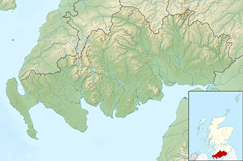The award-winning Dumfries and Galloway Virtual Operations Support Team (DGVOST) is thought to be the first of its kind in the country and was highlighted by the Department for Transport as a best in class innovation.
It is also essentially ‘a map and a blog’ and only cost ‘£250 to get the domain name and get the website running’, Neil Sturrock, senior organisational resilience advisor at Dumfries and Galloway, told Cold Comfort Scotland delegates.

Yet for all its simplicity its effectiveness has been transformative – in fact, it has become a victim of its success somewhat.
The blog is ‘activated’ during emergencies notably extreme weather incidents, during which the council deploys ‘a trusted team of social media savvy individuals to monitor social media feeds for anything that could help responding emergency teams do a better job’.
These individuals are normally council workers and volunteers who receive information through social media and trusted channels.
Information verified through the system is disseminated to the public, as well as partner agencies, through the website to help counter misinformation.
The benefits of this social media filtering include ‘enhanced intelligence gathering, reduced pressure on call centres, reduced media demands, immediacy, transparency and low cost’.
It also helps extend the council’s reach, having a dedicated team using the VOST means that messaging can be pushed out more quickly and effectively across all channels. During the ‘Beast from the East’, the council notched up 300,000 Facebook hits, despite the fact that the population of its area is only 149,000.
The downside to the VOST is that it is very resource-intensive, requiring council officers to work overtime on top of their day job, which is why it is used in short sharp bursts for an emergency rather than ongoing situations like COVID.
It is also ‘heavily reliant on trusted sources’ Mr Sturrock said.
‘Misinformation comes in various guises. People like to embellish. Let’s not let the truth get in the way of a good story. If it's a foot of snow, it's four feet of snow. We are heavily reliant on trusted individuals in resilience groups. We are not putting them in harm’s way or sending them into a situation where they will be at harm on deployment. It’s about situational awareness,’ he stressed.
In order to enlist these trusted individuals, the council relies on local resilience and community groups, as well as volunteers.
‘We are not asking for credentials but we do give them a certain amount of training and give them knowledge of DGVOST, previous deployments, how the Civil Contingencies Act works, how the police and council work. We work with these community resilience groups aside from DGVOST. Some community groups have a greater reach than the council.’
The system has been deployed for
- Storm Desmond Dec 2015
- Storm Frank Dec 2015
- Ex Ophelia (Storm Brian) Oct 2017
- New DGRI transfer of patients Dec 2017
- Snow Event Jan 2018
- Beast from the East Feb/Mar 2018
- Storm Ali Sep 2018
- Amber Warning December 2018
- Storm Dennis Feb 2020
- Standing Water Oct 2021
- Wind and Snow December 2021
The VOST's origins date back to around 13 years ago when an area of Dumfries was completely cut off because of floodwater and the council was unaware of the extent of the situation for 24 hours.
‘We did not know because the information was not flowing,’ Mr Sturrock said.
This situation meant the council formed a ‘multi-agency basis to try something new’ as well as a ‘person’s at risk database’ - from this DGVOST was developed.
It still has lessons to learn and room for development, as was proven by the fact the team did not deploy the platform for Storm Arwen.
As Mr Sturrock explained, for weather events the VOST is deployed based on a graduated weather plan, contextualised information from SEPA and the Met Office and then an agreement between partners.
Met Office warnings provide a colour coded risk alert, and for Arwen the warning was only yellow (rather than higher alerts at amber and red).
This was a ‘big learning point’ Mr Sturrock said: ‘We were guided by the colours rather than the narrative and the information coming in. We had a lot of criticism for not deploying during storm Arwen.’
Interestingly in Storm Arwen, the Scottish Government 'asked for granular information about vulnerabilities and vulnerable people'.
'That is something we have never really seen before – previously they just asked if everything was ok.'
In the long run, the current system may be unsustainable because it is so resource intensive and so the council is looking to automate the situation reports created by the system as well as find other efficiencies.
‘We have to change what we do but it’s about how we change and keep the trust of the public,’ Mr Sturrock said but concluded: ‘I could not be without the VOST. I hope other councils consider it.’
Cold Comfort 2022 (introducing Climate UK), the 29th Annual Winter Service Conference and Exhibition, takes place at the Harrogate Convention Centre on 25 and 26 May 2022.




